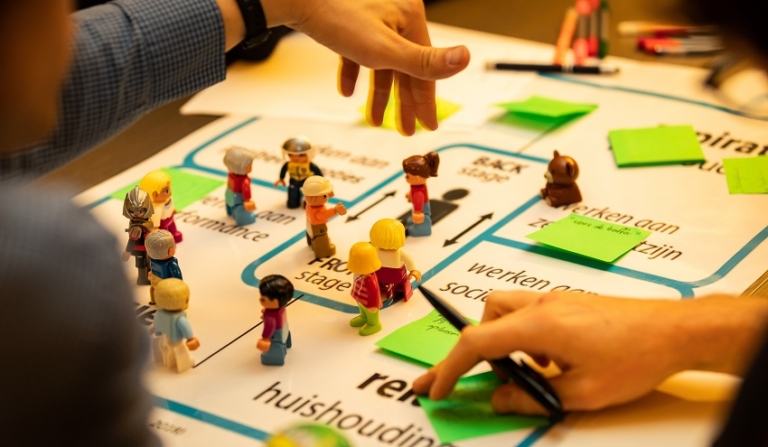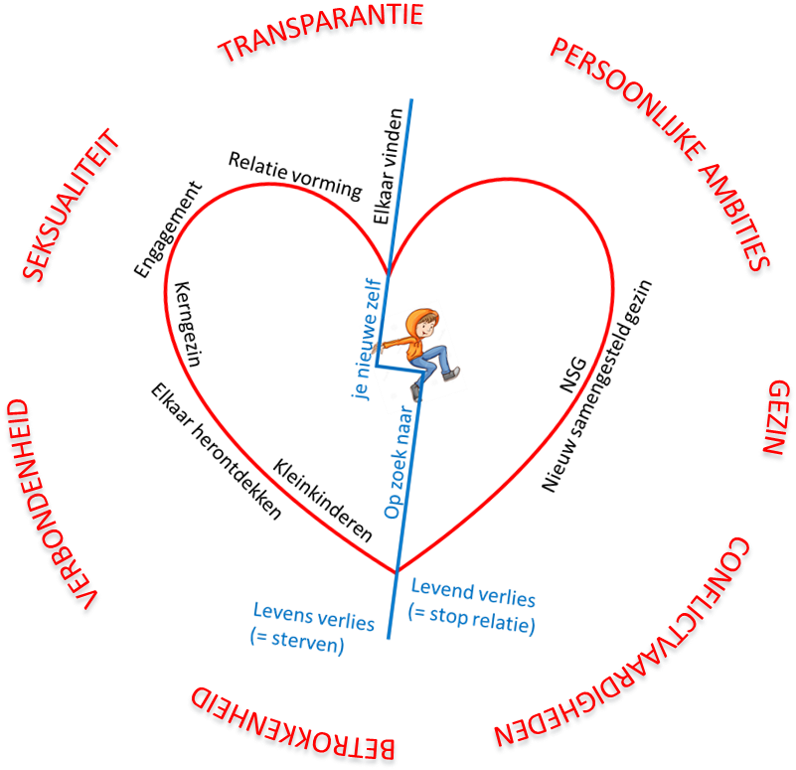Interactions between people are described in systems theory and group dynamics, a part of social psychology.
The social view entails looking at psychological problems from an organizational point of view rather than from the individual’s perception.
The basic axiom is that when you change as a person, the others who interact with you will also behave differently. This is a canker of an axiom because it allows us by looking at ourselves and consciously behaving differently (including thinking and feeling) we change patterns of interaction.
Relationship therapy focuses on improving the relationship between two adults.
Family therapy also involves the children in this. Feature is that all members are present together.
Systems theory provides a strong theoretical framework to include the interactions between people and their environment.
However, there is not necessarily an unambiguous relationship between cause and effect (as is assumed in the medical model).
Reality is represented as a system: A set of interrelated elements, influencing each other over and over. Emphasis is not on the elements but on the inter-network of relationships that influence the elements.
Since it deals primarily with relationships and/or family structures, systems theory is also applied to groups and organizations.
Approaches:
- Structural approach focuses on pathological family structures. It was determined that delinquent youths relapsed upon returning to the family after improvement and counseling.
- An excess of engagement (emneshment) or a lack of it (disengagement) would underlie this.
- Psychological problems can be helpful for family balance (scapegoat phenomenon)
- Communication theoretical approach. Focuses on the fixed patterns or laws in the way people communicate with each other.
- Intergenerational or contextual approach. Combination of systems theory and psychodynamic views. It looks at the relationships of at least three generations.
- Loyalties are an important part of this approach. This finds important applications regarding newly formed families.
Combining systemic therapy with other individual interventions is a solid integration with lasting results.
Subsystems mutually influence each other within an organized whole. Any change in one part of the system affects all other subsystems and the entire system.
The whole of a system is more than the sum of all its subsystems.
Closed systems do not interact with the environment.
Open systems interact with the environment. Feedback always returns the system to an equilibrium state (not necessarily the original one)
Cause and effect are not clearly distinguishable. Interactions take place according to the circular model;
A influences B and B in turn influences A. As a result, A is both cause and effect together.
Partner and family systems are good examples of this functioning.
Subsystems are e.g. Parents, children, etc.
Changes can be stimulated as well as inhibited. E.g. birth of child is positive and getting sick of a family member is negative.
A family member’s disorder may indicate a dysfunctional system but a dysfunctional family member may also negatively affect the system. We work with this when family members have mental or physical issues. Think about how a family member with severe autism will affect family dynamics. The attention to the family member in question should be sufficient but in practice we see that it often gets too much of the attention causing other family members to suffer.
Besides the typical circular relationships, there are also linear ones (cause and effect unambiguous). Examples include partner violence and abuse.
Structural approach: Focuses on the family structure. A clear hierarchy is seen as important that must be respected by all family members.
Boundaries of subsystems to the system are important for a healthy structure.
Two structures are distinguished
Tangled Family
. Boundaries between subsystems are blurred. All members have a close relationship and are very involved with each other. Few relationships are maintained with the outside world. This togetherness leaves little room for individual development.
Loose sand family
. Mirror image of the tangle family. Little communication between members with a distant relationship. Rigid boundaries between family members and boundaries between family and outside world are very blurred.
Communication theoretical approach
: Emphasis is placed on how family members communicate with each other.
Family is considered a rule guided system. Rules can be explicitly present or implicit.
All behavior is communication. So verbal and nonverbal. No communication is impossible.
Communication runs at the content and relationship level. Content level is that which is spoken. Relation level is the mode of communication. (Facial expressions, imposing posture, etc.)
Punctuation. Is its own ordering in a series of events. People assume that reality as they see it is the true one. Reality is that reality is so complex that the same event is explained differently each time by multiple people.
Digital and analog communications. Digital beats language. Analogy on the nonverbal aspects. Symptoms of mental illness are seen as a form of analogous communication. E.g., someone with fear of the streets is seen as communicating that they cannot do the shopping. (Secondary and tertiary disease gains)
Intergenerational approach
: Relationships between people are described as an emotional profit and loss account. A healthy relationship is a balance of give and take. ‘Giving’ means taking into account interests and position of the other person; Imbalance manifests itself in relational debt that can be redeemed by giving the other person what they are entitled to. Loyalty is important. (Horizontal, vertical, primary, invisible, split).
Walsha uses these insights to make symptoms and problems disappear or diminish by changing patterns of interaction in the here and now. Those involved need to start behaving differently toward each other.
Family problems are often hidden relationship problems!

Partner choice is primarily not in question. If it does, the goal shifts from relationship enhancement to relationship resolution.
An example of the system model is working with duplo dolls. This maps out interactions in a visual and playful way.

Walsha looks at relationships and families from a life course perspective. Here Walsha goes much broader than traditional relationship or family therapy.
The relationship life cycle includes:
- Finding each other
- Relationship Building
- Engagement as a couple
- Core family
- Rediscovering each other
- Grandchildren
- Living loss = relationship stop
- Living loss = end of life
- In search of your (new) self
- Newly Composite Families
Walsha works preventively in a pleasant way. At every stage of your adult life journey, we help you move forward.